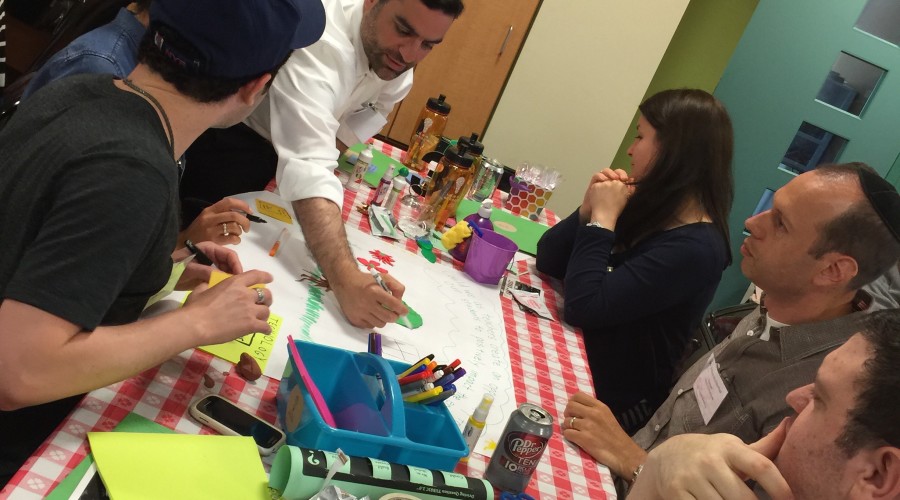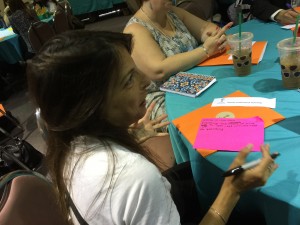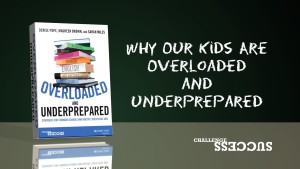Play the School Day Redesign Game
The Summer Sandboxes
The Summer Sandbox, the I.D.E.A. Schools Network project-based learning (PBL) conference, has run for three years on the East Coast and was introduced to the West Coast this past July. Educators attend the Sandbox to learn about PBL — what its components are, how to project design and create alternative assessments, how to weave creativity and innovation into a PBL unit, how to include student voice and choice — and the culture in which it thrives. We like to begin each day of the Sandbox with ice breakers that reflect PBL pedagogy and also get participants thinking in new ways about school and how it’s run. On the second day of both the East and West Coast Sandboxes this year, we asked attendees to redesign the school day, and this is a great activity to do at professional development or with students themselves. It would be interesting to see what kids come up with.
This was the “assignment” we gave our participants:
School Day Redesign
Challenging Problem:
The I.D.E.A. Schools Network has been asked to create a PBL school and needs your help restructuring the school day.
EAT. PRAY. PLAY.
All we need to retain in the school day is lunch, a minimum of one prayer/meditation service, and physical exercise.
Redesign the school day using those parameters. Anything else about the current day can change.
Age: 6th grade to adult
Size of each group: 6-8 people
Context: professional development or student ice breaker
Time frame: 30-40 minutes
Materials: Large post-its for the group to write their schedule on. Sharpies. We had each group post their schedule and created a gallery of the schedules that participants could view.
We had the groups work for 20-25 minutes and then we shared out for 10-15 minutes. Our share out didn’t focus on what kind of school day the groups created. Rather, we focused on the process. Thanks to Dr. Yechiel Hoffman, for facilitating the share out on the West Coast and developing the reflection questions, and to Mrs. Leah Herzog, for facilitating the discussion on the East Coast. Here are some reflection questions we asked:
Who found the challenge fun? Scary? Hard? One or more? Why?
Did you stick to the rules of the game? Did you stick to your roles? Why or why not?
How did you work as a group? Was it easy to collaborate? Especially if you were in your roles?
Gaming School
We divided participants up by table, and an additional element to the ice breaker was that we had each participant play a role in his/her group. For example, we had the educators play the role of principal, director of educational technology, math teacher, parent, 2nd grader, 7th grader, 10th grader, and parent.
One of the elements that’s key for us in this “game” is the fact that educators get to experience what it’s like to be handed a challenge that they have to figure out. This lets them experience what it’s like as a student to be handed an assignment or project that is a little open-ended, with no right answer. It’s important for teachers to understand exactly what the PBL process feels like from the students’ point of view. In fact, creating empathy is something that’s key in PBL: when we were project designing at the Sandboxes, we noted that while we began planning PBL units with the curriculum we wanted to cover or the success skills — such as reading comprehension, collaboration, digital literacy, or oral presentation — we wanted to build, we ended by considering how our students would be growing socially and emotionally.
An example: when we were project tuning a middle school history PBL unit, we started by building into the unit the immigration curriculum that the teachers wanted to cover. The unit asked students to explore their own family’s immigration story — finding it no matter how far back it went — connecting it to various others’ throughout history and then to the early twentieth century in America, the focal point of the history unit. The unit built empathy by asking students in multiple ways what it meant to be “new” in an environment, whether that environment was school, a neighborhood, or a new country. Anti-bullying and anti-discrimination campaigns ended up being included in the PBL unit. While the latter was a more obvious way to get students to grow emotionally through the unit, the former was one that surprised us all, but made us realize how much the learning could permeate areas we had never intended it to go.
Another way this element of empathy was created through the ice breaker was by asking participants to inhabit a persona other than their own. Of course, watching participants sticking to the role of 2nd or 7th grader or sophomore was often hilarious — in fact, one group had so many recess and juice bar breaks that we had to ask them if perhaps they had given their students a bit too much voice in the decision-making process. But the exercise produced fascinating results. When we reflected on the activity, one participant at the West Coast Sandbox commented, “I kept finding myself reverting back to being me. I had to remind myself to play the role I was assigned.” Others admitted that they had found the roles too hard and had simply abandoned them, planning the school day in their own voices. We were able to point out at the reflection the importance of trying to get into someone else’s shoes and feeling what the world looks like from their view.
A New School Day
Of course, the actual exercise was appealing to us as well. One of the goals of the Sandbox is to push participants to change paradigms, to really challenge the status quo. Educational Consultant Jonathan Cannon talks about this frequently, asking educators if they’re stuck by TWWADI: The Way We’ve Always Done It. Interesting for us to note was that many groups didn’t really change the structure of the school day all that much, even given the parameters of the game. Other groups really blew up the school day schedule: they had interdisciplinary blocks of learning that were not divided by subject but by thoughtfully designed learning experiences that covered a multitude of disciplines. Whatever disciplines weren’t covered by one learning block were covered by another. In this new paradigm, teachers and students worked in teams to produce the projects, and learning blocks were bracketed by time throughout the day to eat, pray or meditate, exercise, and reflect. In short, the day provided opportunities to learn in a rigorous, creative way, but also to sit back, take a break, or to think about learning in a mindful way.
Overloaded and Underprepared
In Denise Pope, Maureen Brown, and Sarah Miles’ new book, Overloaded and Underprepared, the researchers ask us to question the status quo of loading down students with so many subjects and so much work that kids don’t have time to breathe, reflect, or perhaps even exercise properly, given the demanding schedules they have. Chapter Two of the book is entitled “A Saner Schedule” and asks us to re-evaluate the school day. Actually, the book came out on the first day of the West Coast Sandbox, July 23, so our ice breaker turned out to be a funny coincidence. Or not such a coincidence: we’re all thinking, it seems, that our kids are doing too much, that their school days and nights of extra-curricular activities are just too exhausting. For that matter, we might be noticing that despite advances in technologies that supposedly make our lives easier, we as adults are working too hard and are having a harder time than ever before achieving a work-life balance.
One suggestion that Overloaded and Underprepared makes is to give middle and high schoolers a later start time. This idea comes with the backing of recent neuroscience research which shows that the circadian rhythm of teenagers differs from an adult one. The fact that teenagers tend to sleep late and stay up late isn’t something that’s gone unnoticed — in fact, classic fairy tales show an understanding of this basic scientific knowledge, sending heroine after heroine into a deep sleep that anyone who’s been or parented an adolescent can recognize. Pope, Brown, and Miles immediately address the concern of whether a late start time leads to a late school day end that causes conflict with after-school activities and homework by putting forth the idea Sandbox participants came up with: block scheduling. The book also points out that a modified block schedule might be more realistic for schools, especially when they’re first embracing a new way to look at class time slots. A school may want its students to have math or a foreign language every day; frequent, shorter classes may be more appropriate for those courses, but others may benefit from longer stretches of time. Not meeting every day also means students aren’t doing homework for every subject every night.
Magen David Yeshivah High School, one of the Founding Schools of the I.D.E.A. Schools Network, moved to a modified block schedule last school year. The school, which is embracing PBL, understood that the collaboration and creative thinking it needed students to engage in couldn’t be done in 40-45 periods. As the school’s principal Rabbi Saul Zucker says, “We moved to block scheduling to afford our students blocks of time to delve more deeply into a lesson.” Magen David has devoted extensive time and resources — and is continuing to do so this year: twenty teachers from the school came to the East Coast Sandbox, and the Network is recreating one of the Sandbox days during the school’s professional development days next week — to showing faculty how to maximize learning in a block schedule.
As Overloaded and Underprepared points out, “[J]ust stringing together two traditional 45-minute lesson plans to fill a 90-minute block isn’t necessarily going to improve student learning and certainly isn’t taking advantage of what a block schedule might offer in terms of engaging pedagogy and curriculum” (24). Magen David faculty saw that right away and worked throughout the year on developing PBL units, crafting alternative assessments, using rotational models in the classroom, and generally giving students more opportunities to think creatively and produce creative work that reflected their learning. By the end of the first year of working in block scheduling modules, many teachers remarked that they didn’t know how they ever taught in only 40-minute periods!
Rethinking Education
The discussion ten or fifteen years ago was about how to integrate technology into the classroom; while that conversation is and still should be going on, a new one has developed around which are the right pedagogies to employ for today’s world and students. This redesign the school day game gets teachers and students involved in that question. We can’t wait to hear their answers.
Resources
Of course, check out Overloaded and Underprepared: Strategies fro Stronger Schools and Healthy, Successful Kids by Denise Pope, Maureen Brown, and Sarah Miles
Another relevant article is “Tenafly considers giving tired teens relief at school,” North Jersey.com, by Deena Yellin, May 31, 2015.







Recent Comments